Occupational Health and Safety
VerifiedAdded on 2023/04/10
|8
|1850
|387
AI Summary
This essay provides insight into the occupational health and safety of XYZ Enterprise, focusing on worker disability management. It discusses the company's policies, strategies, and recommendations for improving the return to work process.
Contribute Materials
Your contribution can guide someone’s learning journey. Share your
documents today.

Running Head: OCCUPATIONAL HEALTH AND SAFETY
OCCUPATIONAL HEALTH AND SAFETY
Name of the student/:
Name of the university:
Author note:
OCCUPATIONAL HEALTH AND SAFETY
Name of the student/:
Name of the university:
Author note:
Secure Best Marks with AI Grader
Need help grading? Try our AI Grader for instant feedback on your assignments.
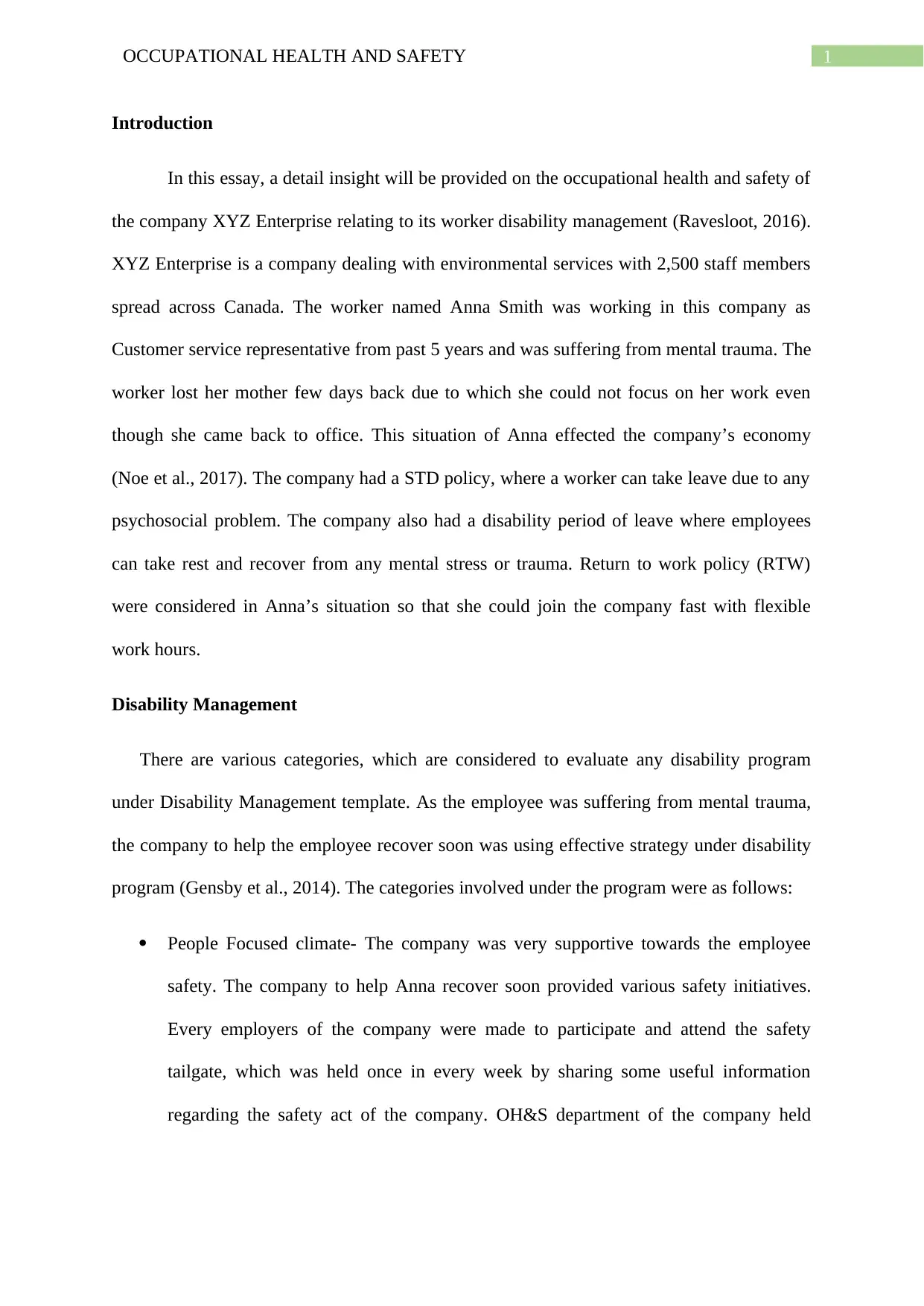
1OCCUPATIONAL HEALTH AND SAFETY
Introduction
In this essay, a detail insight will be provided on the occupational health and safety of
the company XYZ Enterprise relating to its worker disability management (Ravesloot, 2016).
XYZ Enterprise is a company dealing with environmental services with 2,500 staff members
spread across Canada. The worker named Anna Smith was working in this company as
Customer service representative from past 5 years and was suffering from mental trauma. The
worker lost her mother few days back due to which she could not focus on her work even
though she came back to office. This situation of Anna effected the company’s economy
(Noe et al., 2017). The company had a STD policy, where a worker can take leave due to any
psychosocial problem. The company also had a disability period of leave where employees
can take rest and recover from any mental stress or trauma. Return to work policy (RTW)
were considered in Anna’s situation so that she could join the company fast with flexible
work hours.
Disability Management
There are various categories, which are considered to evaluate any disability program
under Disability Management template. As the employee was suffering from mental trauma,
the company to help the employee recover soon was using effective strategy under disability
program (Gensby et al., 2014). The categories involved under the program were as follows:
People Focused climate- The company was very supportive towards the employee
safety. The company to help Anna recover soon provided various safety initiatives.
Every employers of the company were made to participate and attend the safety
tailgate, which was held once in every week by sharing some useful information
regarding the safety act of the company. OH&S department of the company held
Introduction
In this essay, a detail insight will be provided on the occupational health and safety of
the company XYZ Enterprise relating to its worker disability management (Ravesloot, 2016).
XYZ Enterprise is a company dealing with environmental services with 2,500 staff members
spread across Canada. The worker named Anna Smith was working in this company as
Customer service representative from past 5 years and was suffering from mental trauma. The
worker lost her mother few days back due to which she could not focus on her work even
though she came back to office. This situation of Anna effected the company’s economy
(Noe et al., 2017). The company had a STD policy, where a worker can take leave due to any
psychosocial problem. The company also had a disability period of leave where employees
can take rest and recover from any mental stress or trauma. Return to work policy (RTW)
were considered in Anna’s situation so that she could join the company fast with flexible
work hours.
Disability Management
There are various categories, which are considered to evaluate any disability program
under Disability Management template. As the employee was suffering from mental trauma,
the company to help the employee recover soon was using effective strategy under disability
program (Gensby et al., 2014). The categories involved under the program were as follows:
People Focused climate- The company was very supportive towards the employee
safety. The company to help Anna recover soon provided various safety initiatives.
Every employers of the company were made to participate and attend the safety
tailgate, which was held once in every week by sharing some useful information
regarding the safety act of the company. OH&S department of the company held

2OCCUPATIONAL HEALTH AND SAFETY
meetings and safety audits once in every year, which helped the employers to be
updated with the safety policies of the company.
Prevention Focus- There were no such safety records updated by the company with
any background history of the employees. The company did not practice any
employee-centred activities where the employees can discuss about safety concern
and input some ideas regarding any safety regulation. Hence, the company should
conduct different employee-centred activities where the employees can openly discuss
about the safety concern and what kind of modification can lead to prevent the
injuries occurring in the company. Training programs should be conducted frequently
so that the employees can increase their awareness regarding the safety concern and
prevention (Cascio, 2015).
Early intervention and Education- The Company has a supervisor who is accountable
for the cases of injured employees. The injured employees are managed with
discipline rather than taking any corrective actions. The company lacks any third-
party involvement for managing the injured cases and RTW process, which leads to
delay of work and give rise to confusion regarding proper management of the paper
work required by the company (Jetha et al., 2016). Hence, the company should focus
on the management by establishing a separate supervisor who will only focus on the
injured cases, which will help the employees with better communication and clarity
regarding the modified work.
Return to Work Case Management-The coordination between the OH&S department
and HR department was very poor. There was a big confusion regarding the
responsibility for managing the injured-cases. No effective communication was
provide by the organization and the paper work was delayed, which lead to a negative
experience on the injured employees. A proper Return to work plan (RTW) process
meetings and safety audits once in every year, which helped the employers to be
updated with the safety policies of the company.
Prevention Focus- There were no such safety records updated by the company with
any background history of the employees. The company did not practice any
employee-centred activities where the employees can discuss about safety concern
and input some ideas regarding any safety regulation. Hence, the company should
conduct different employee-centred activities where the employees can openly discuss
about the safety concern and what kind of modification can lead to prevent the
injuries occurring in the company. Training programs should be conducted frequently
so that the employees can increase their awareness regarding the safety concern and
prevention (Cascio, 2015).
Early intervention and Education- The Company has a supervisor who is accountable
for the cases of injured employees. The injured employees are managed with
discipline rather than taking any corrective actions. The company lacks any third-
party involvement for managing the injured cases and RTW process, which leads to
delay of work and give rise to confusion regarding proper management of the paper
work required by the company (Jetha et al., 2016). Hence, the company should focus
on the management by establishing a separate supervisor who will only focus on the
injured cases, which will help the employees with better communication and clarity
regarding the modified work.
Return to Work Case Management-The coordination between the OH&S department
and HR department was very poor. There was a big confusion regarding the
responsibility for managing the injured-cases. No effective communication was
provide by the organization and the paper work was delayed, which lead to a negative
experience on the injured employees. A proper Return to work plan (RTW) process
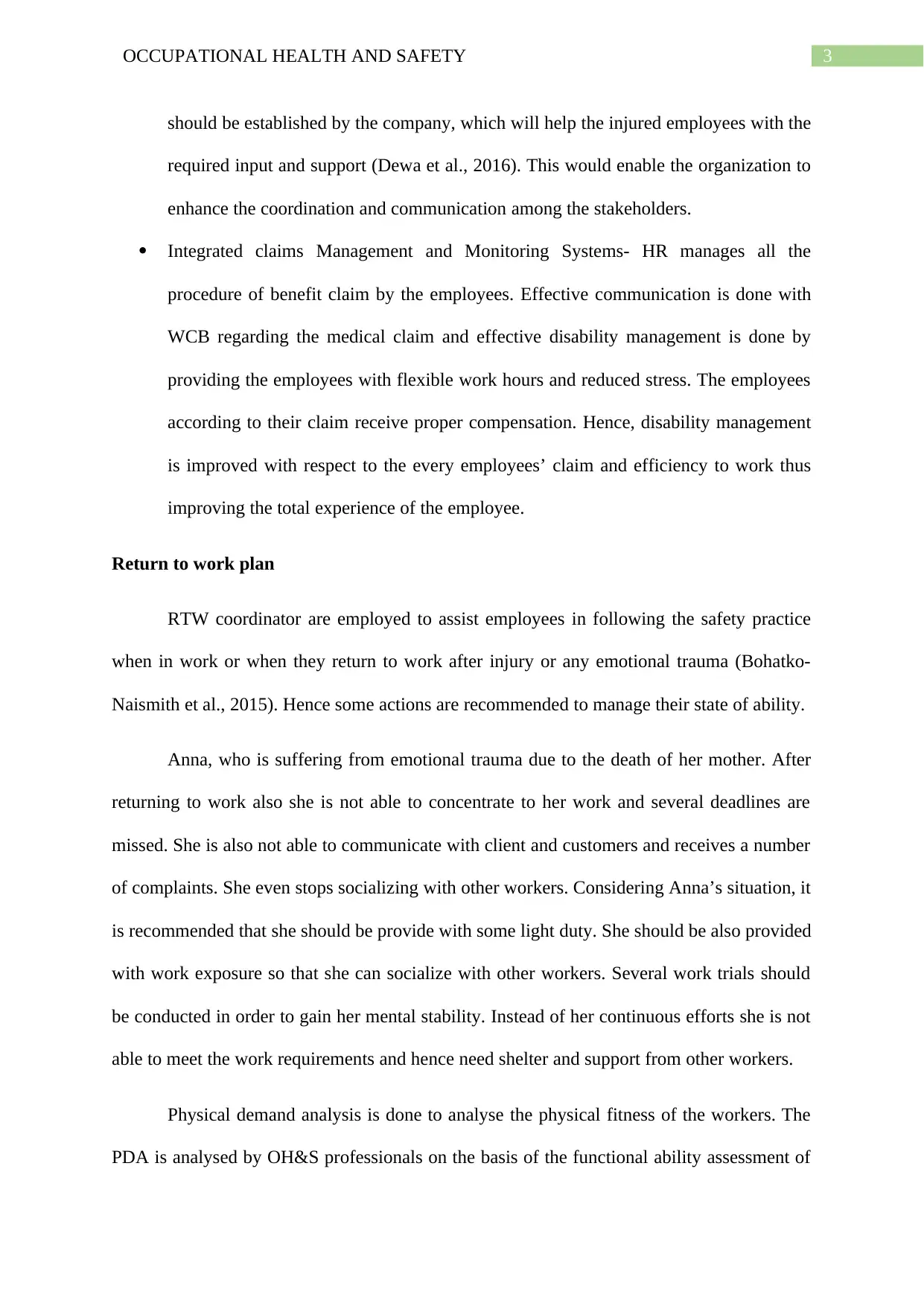
3OCCUPATIONAL HEALTH AND SAFETY
should be established by the company, which will help the injured employees with the
required input and support (Dewa et al., 2016). This would enable the organization to
enhance the coordination and communication among the stakeholders.
Integrated claims Management and Monitoring Systems- HR manages all the
procedure of benefit claim by the employees. Effective communication is done with
WCB regarding the medical claim and effective disability management is done by
providing the employees with flexible work hours and reduced stress. The employees
according to their claim receive proper compensation. Hence, disability management
is improved with respect to the every employees’ claim and efficiency to work thus
improving the total experience of the employee.
Return to work plan
RTW coordinator are employed to assist employees in following the safety practice
when in work or when they return to work after injury or any emotional trauma (Bohatko-
Naismith et al., 2015). Hence some actions are recommended to manage their state of ability.
Anna, who is suffering from emotional trauma due to the death of her mother. After
returning to work also she is not able to concentrate to her work and several deadlines are
missed. She is also not able to communicate with client and customers and receives a number
of complaints. She even stops socializing with other workers. Considering Anna’s situation, it
is recommended that she should be provide with some light duty. She should be also provided
with work exposure so that she can socialize with other workers. Several work trials should
be conducted in order to gain her mental stability. Instead of her continuous efforts she is not
able to meet the work requirements and hence need shelter and support from other workers.
Physical demand analysis is done to analyse the physical fitness of the workers. The
PDA is analysed by OH&S professionals on the basis of the functional ability assessment of
should be established by the company, which will help the injured employees with the
required input and support (Dewa et al., 2016). This would enable the organization to
enhance the coordination and communication among the stakeholders.
Integrated claims Management and Monitoring Systems- HR manages all the
procedure of benefit claim by the employees. Effective communication is done with
WCB regarding the medical claim and effective disability management is done by
providing the employees with flexible work hours and reduced stress. The employees
according to their claim receive proper compensation. Hence, disability management
is improved with respect to the every employees’ claim and efficiency to work thus
improving the total experience of the employee.
Return to work plan
RTW coordinator are employed to assist employees in following the safety practice
when in work or when they return to work after injury or any emotional trauma (Bohatko-
Naismith et al., 2015). Hence some actions are recommended to manage their state of ability.
Anna, who is suffering from emotional trauma due to the death of her mother. After
returning to work also she is not able to concentrate to her work and several deadlines are
missed. She is also not able to communicate with client and customers and receives a number
of complaints. She even stops socializing with other workers. Considering Anna’s situation, it
is recommended that she should be provide with some light duty. She should be also provided
with work exposure so that she can socialize with other workers. Several work trials should
be conducted in order to gain her mental stability. Instead of her continuous efforts she is not
able to meet the work requirements and hence need shelter and support from other workers.
Physical demand analysis is done to analyse the physical fitness of the workers. The
PDA is analysed by OH&S professionals on the basis of the functional ability assessment of
Secure Best Marks with AI Grader
Need help grading? Try our AI Grader for instant feedback on your assignments.
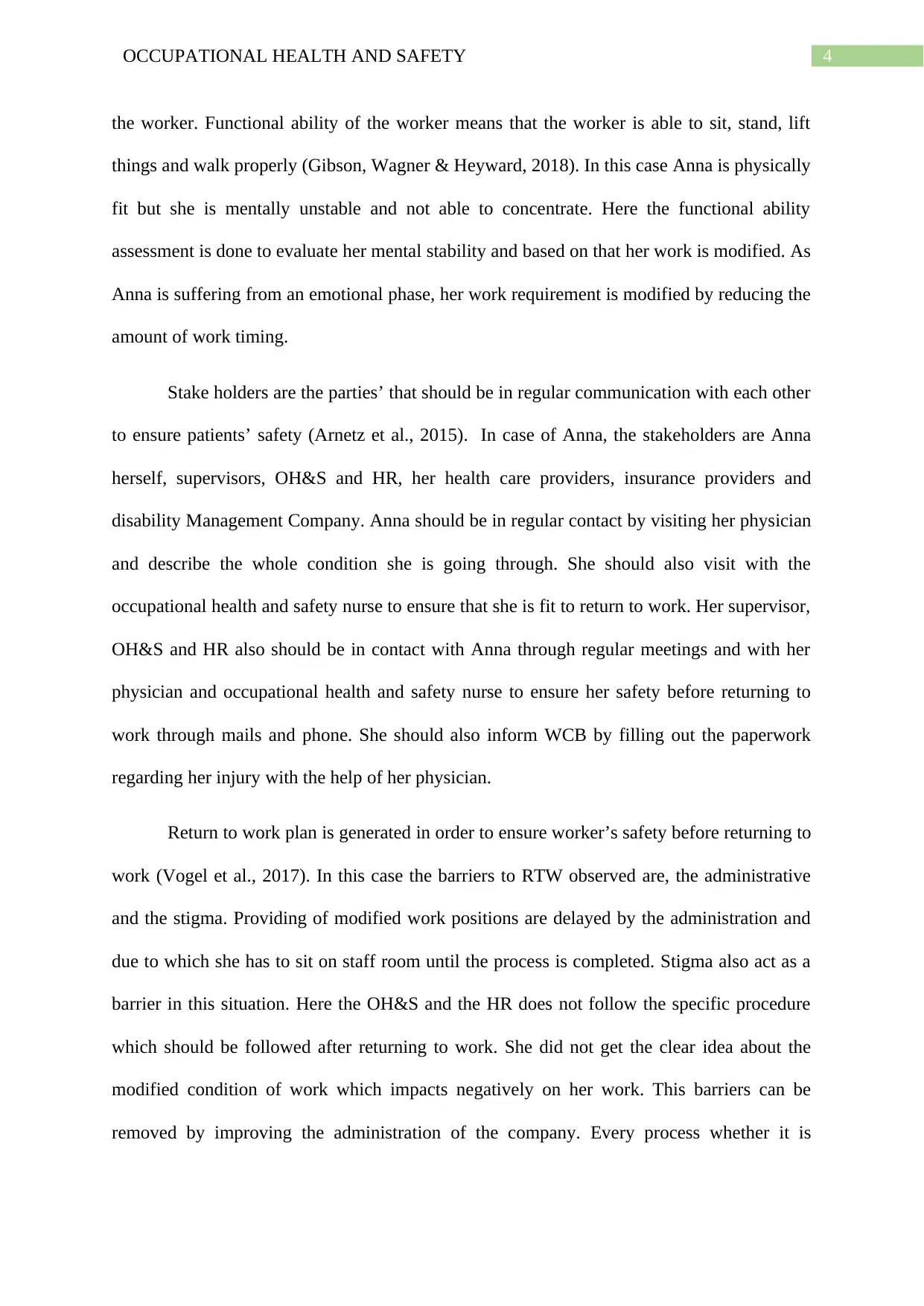
4OCCUPATIONAL HEALTH AND SAFETY
the worker. Functional ability of the worker means that the worker is able to sit, stand, lift
things and walk properly (Gibson, Wagner & Heyward, 2018). In this case Anna is physically
fit but she is mentally unstable and not able to concentrate. Here the functional ability
assessment is done to evaluate her mental stability and based on that her work is modified. As
Anna is suffering from an emotional phase, her work requirement is modified by reducing the
amount of work timing.
Stake holders are the parties’ that should be in regular communication with each other
to ensure patients’ safety (Arnetz et al., 2015). In case of Anna, the stakeholders are Anna
herself, supervisors, OH&S and HR, her health care providers, insurance providers and
disability Management Company. Anna should be in regular contact by visiting her physician
and describe the whole condition she is going through. She should also visit with the
occupational health and safety nurse to ensure that she is fit to return to work. Her supervisor,
OH&S and HR also should be in contact with Anna through regular meetings and with her
physician and occupational health and safety nurse to ensure her safety before returning to
work through mails and phone. She should also inform WCB by filling out the paperwork
regarding her injury with the help of her physician.
Return to work plan is generated in order to ensure worker’s safety before returning to
work (Vogel et al., 2017). In this case the barriers to RTW observed are, the administrative
and the stigma. Providing of modified work positions are delayed by the administration and
due to which she has to sit on staff room until the process is completed. Stigma also act as a
barrier in this situation. Here the OH&S and the HR does not follow the specific procedure
which should be followed after returning to work. She did not get the clear idea about the
modified condition of work which impacts negatively on her work. This barriers can be
removed by improving the administration of the company. Every process whether it is
the worker. Functional ability of the worker means that the worker is able to sit, stand, lift
things and walk properly (Gibson, Wagner & Heyward, 2018). In this case Anna is physically
fit but she is mentally unstable and not able to concentrate. Here the functional ability
assessment is done to evaluate her mental stability and based on that her work is modified. As
Anna is suffering from an emotional phase, her work requirement is modified by reducing the
amount of work timing.
Stake holders are the parties’ that should be in regular communication with each other
to ensure patients’ safety (Arnetz et al., 2015). In case of Anna, the stakeholders are Anna
herself, supervisors, OH&S and HR, her health care providers, insurance providers and
disability Management Company. Anna should be in regular contact by visiting her physician
and describe the whole condition she is going through. She should also visit with the
occupational health and safety nurse to ensure that she is fit to return to work. Her supervisor,
OH&S and HR also should be in contact with Anna through regular meetings and with her
physician and occupational health and safety nurse to ensure her safety before returning to
work through mails and phone. She should also inform WCB by filling out the paperwork
regarding her injury with the help of her physician.
Return to work plan is generated in order to ensure worker’s safety before returning to
work (Vogel et al., 2017). In this case the barriers to RTW observed are, the administrative
and the stigma. Providing of modified work positions are delayed by the administration and
due to which she has to sit on staff room until the process is completed. Stigma also act as a
barrier in this situation. Here the OH&S and the HR does not follow the specific procedure
which should be followed after returning to work. She did not get the clear idea about the
modified condition of work which impacts negatively on her work. This barriers can be
removed by improving the administration of the company. Every process whether it is
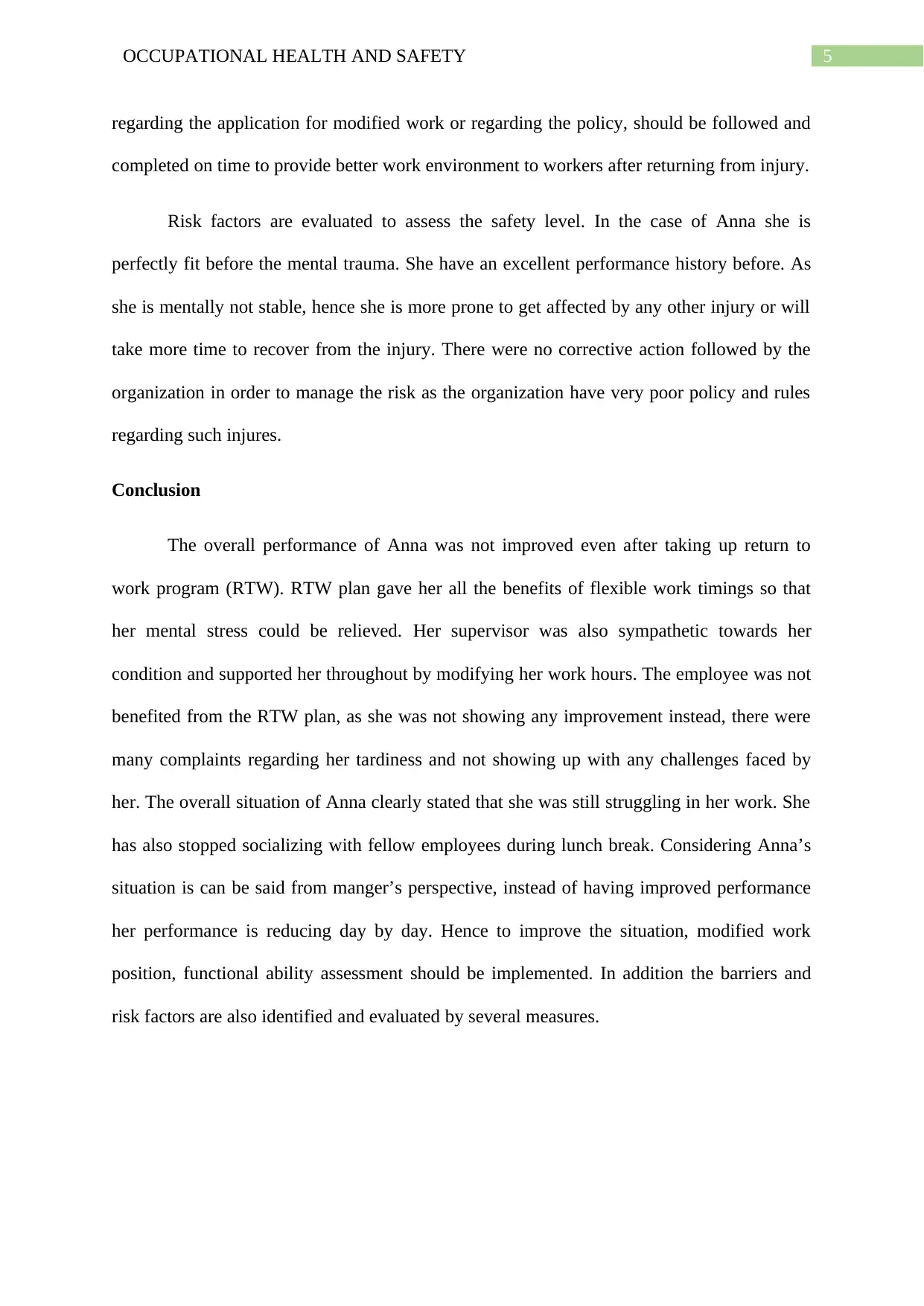
5OCCUPATIONAL HEALTH AND SAFETY
regarding the application for modified work or regarding the policy, should be followed and
completed on time to provide better work environment to workers after returning from injury.
Risk factors are evaluated to assess the safety level. In the case of Anna she is
perfectly fit before the mental trauma. She have an excellent performance history before. As
she is mentally not stable, hence she is more prone to get affected by any other injury or will
take more time to recover from the injury. There were no corrective action followed by the
organization in order to manage the risk as the organization have very poor policy and rules
regarding such injures.
Conclusion
The overall performance of Anna was not improved even after taking up return to
work program (RTW). RTW plan gave her all the benefits of flexible work timings so that
her mental stress could be relieved. Her supervisor was also sympathetic towards her
condition and supported her throughout by modifying her work hours. The employee was not
benefited from the RTW plan, as she was not showing any improvement instead, there were
many complaints regarding her tardiness and not showing up with any challenges faced by
her. The overall situation of Anna clearly stated that she was still struggling in her work. She
has also stopped socializing with fellow employees during lunch break. Considering Anna’s
situation is can be said from manger’s perspective, instead of having improved performance
her performance is reducing day by day. Hence to improve the situation, modified work
position, functional ability assessment should be implemented. In addition the barriers and
risk factors are also identified and evaluated by several measures.
regarding the application for modified work or regarding the policy, should be followed and
completed on time to provide better work environment to workers after returning from injury.
Risk factors are evaluated to assess the safety level. In the case of Anna she is
perfectly fit before the mental trauma. She have an excellent performance history before. As
she is mentally not stable, hence she is more prone to get affected by any other injury or will
take more time to recover from the injury. There were no corrective action followed by the
organization in order to manage the risk as the organization have very poor policy and rules
regarding such injures.
Conclusion
The overall performance of Anna was not improved even after taking up return to
work program (RTW). RTW plan gave her all the benefits of flexible work timings so that
her mental stress could be relieved. Her supervisor was also sympathetic towards her
condition and supported her throughout by modifying her work hours. The employee was not
benefited from the RTW plan, as she was not showing any improvement instead, there were
many complaints regarding her tardiness and not showing up with any challenges faced by
her. The overall situation of Anna clearly stated that she was still struggling in her work. She
has also stopped socializing with fellow employees during lunch break. Considering Anna’s
situation is can be said from manger’s perspective, instead of having improved performance
her performance is reducing day by day. Hence to improve the situation, modified work
position, functional ability assessment should be implemented. In addition the barriers and
risk factors are also identified and evaluated by several measures.
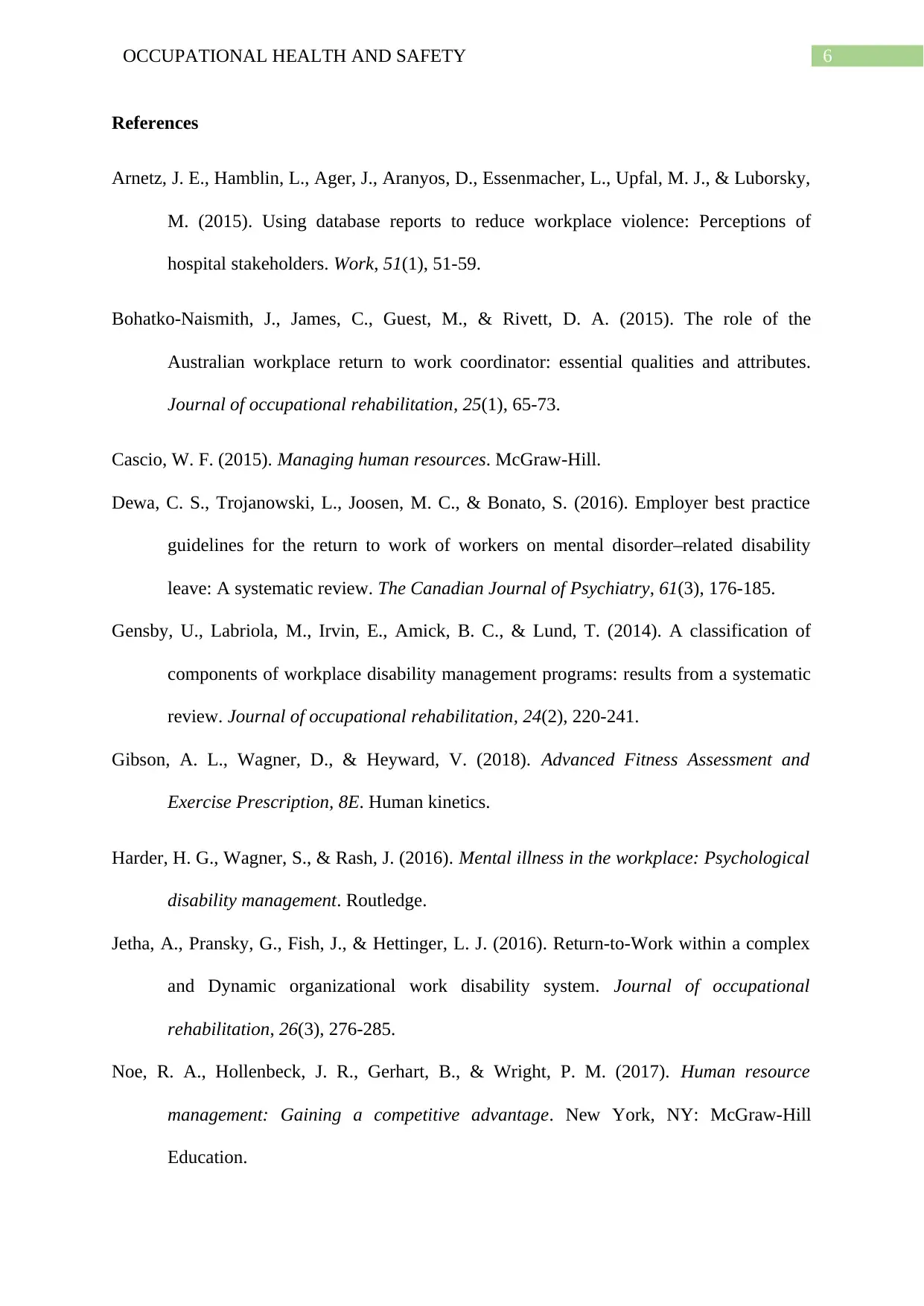
6OCCUPATIONAL HEALTH AND SAFETY
References
Arnetz, J. E., Hamblin, L., Ager, J., Aranyos, D., Essenmacher, L., Upfal, M. J., & Luborsky,
M. (2015). Using database reports to reduce workplace violence: Perceptions of
hospital stakeholders. Work, 51(1), 51-59.
Bohatko-Naismith, J., James, C., Guest, M., & Rivett, D. A. (2015). The role of the
Australian workplace return to work coordinator: essential qualities and attributes.
Journal of occupational rehabilitation, 25(1), 65-73.
Cascio, W. F. (2015). Managing human resources. McGraw-Hill.
Dewa, C. S., Trojanowski, L., Joosen, M. C., & Bonato, S. (2016). Employer best practice
guidelines for the return to work of workers on mental disorder–related disability
leave: A systematic review. The Canadian Journal of Psychiatry, 61(3), 176-185.
Gensby, U., Labriola, M., Irvin, E., Amick, B. C., & Lund, T. (2014). A classification of
components of workplace disability management programs: results from a systematic
review. Journal of occupational rehabilitation, 24(2), 220-241.
Gibson, A. L., Wagner, D., & Heyward, V. (2018). Advanced Fitness Assessment and
Exercise Prescription, 8E. Human kinetics.
Harder, H. G., Wagner, S., & Rash, J. (2016). Mental illness in the workplace: Psychological
disability management. Routledge.
Jetha, A., Pransky, G., Fish, J., & Hettinger, L. J. (2016). Return-to-Work within a complex
and Dynamic organizational work disability system. Journal of occupational
rehabilitation, 26(3), 276-285.
Noe, R. A., Hollenbeck, J. R., Gerhart, B., & Wright, P. M. (2017). Human resource
management: Gaining a competitive advantage. New York, NY: McGraw-Hill
Education.
References
Arnetz, J. E., Hamblin, L., Ager, J., Aranyos, D., Essenmacher, L., Upfal, M. J., & Luborsky,
M. (2015). Using database reports to reduce workplace violence: Perceptions of
hospital stakeholders. Work, 51(1), 51-59.
Bohatko-Naismith, J., James, C., Guest, M., & Rivett, D. A. (2015). The role of the
Australian workplace return to work coordinator: essential qualities and attributes.
Journal of occupational rehabilitation, 25(1), 65-73.
Cascio, W. F. (2015). Managing human resources. McGraw-Hill.
Dewa, C. S., Trojanowski, L., Joosen, M. C., & Bonato, S. (2016). Employer best practice
guidelines for the return to work of workers on mental disorder–related disability
leave: A systematic review. The Canadian Journal of Psychiatry, 61(3), 176-185.
Gensby, U., Labriola, M., Irvin, E., Amick, B. C., & Lund, T. (2014). A classification of
components of workplace disability management programs: results from a systematic
review. Journal of occupational rehabilitation, 24(2), 220-241.
Gibson, A. L., Wagner, D., & Heyward, V. (2018). Advanced Fitness Assessment and
Exercise Prescription, 8E. Human kinetics.
Harder, H. G., Wagner, S., & Rash, J. (2016). Mental illness in the workplace: Psychological
disability management. Routledge.
Jetha, A., Pransky, G., Fish, J., & Hettinger, L. J. (2016). Return-to-Work within a complex
and Dynamic organizational work disability system. Journal of occupational
rehabilitation, 26(3), 276-285.
Noe, R. A., Hollenbeck, J. R., Gerhart, B., & Wright, P. M. (2017). Human resource
management: Gaining a competitive advantage. New York, NY: McGraw-Hill
Education.
Paraphrase This Document
Need a fresh take? Get an instant paraphrase of this document with our AI Paraphraser
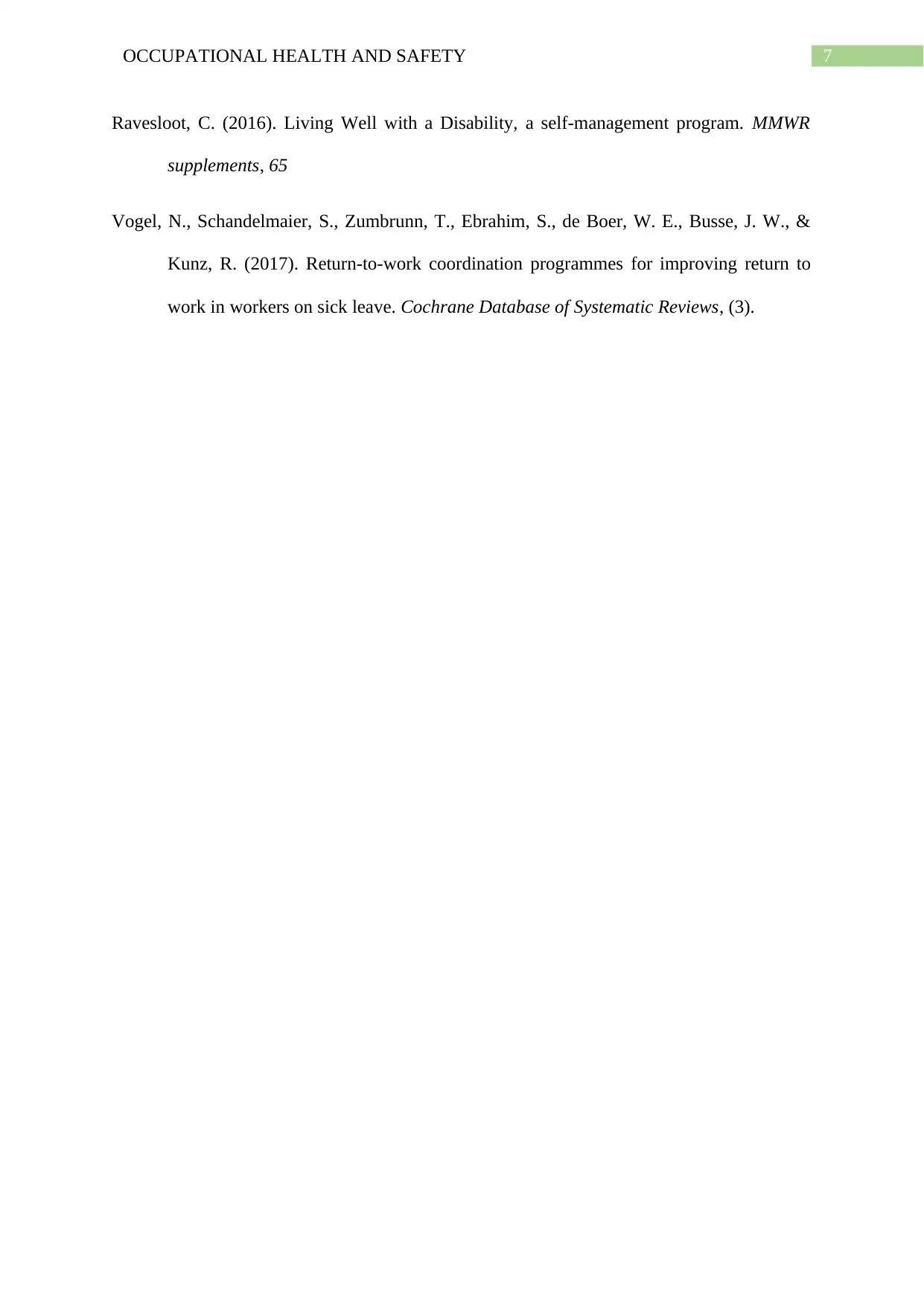
7OCCUPATIONAL HEALTH AND SAFETY
Ravesloot, C. (2016). Living Well with a Disability, a self-management program. MMWR
supplements, 65
Vogel, N., Schandelmaier, S., Zumbrunn, T., Ebrahim, S., de Boer, W. E., Busse, J. W., &
Kunz, R. (2017). Return‐to‐work coordination programmes for improving return to
work in workers on sick leave. Cochrane Database of Systematic Reviews, (3).
Ravesloot, C. (2016). Living Well with a Disability, a self-management program. MMWR
supplements, 65
Vogel, N., Schandelmaier, S., Zumbrunn, T., Ebrahim, S., de Boer, W. E., Busse, J. W., &
Kunz, R. (2017). Return‐to‐work coordination programmes for improving return to
work in workers on sick leave. Cochrane Database of Systematic Reviews, (3).
1 out of 8
Related Documents
Your All-in-One AI-Powered Toolkit for Academic Success.
+13062052269
info@desklib.com
Available 24*7 on WhatsApp / Email
![[object Object]](/_next/static/media/star-bottom.7253800d.svg)
Unlock your academic potential
© 2024 | Zucol Services PVT LTD | All rights reserved.



